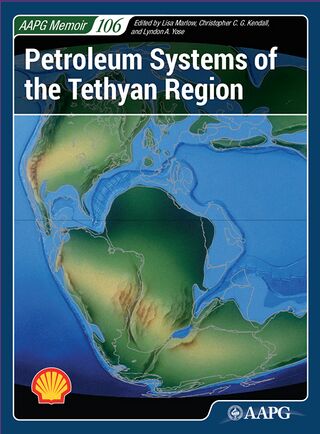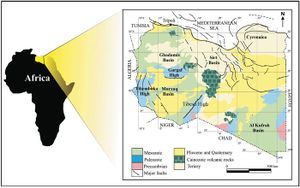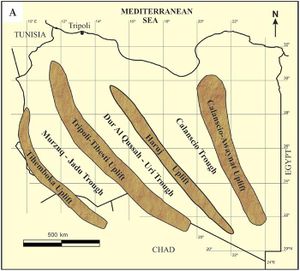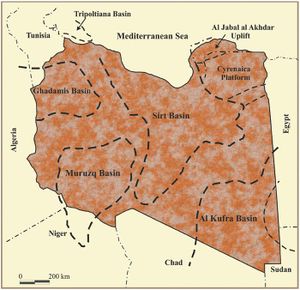Libya hydrocarbon provinces
| Petroleum systems of the Tethyan region | |

| |
| Series | AAPG Memoir |
|---|---|
| Chapter | Hydrocarbon Provinces of Libya: A Petroleum System Study |
| Author | Hassan S. Hassan and Christopher C. G. Kendall |
| Link | Web page |
| Store | AAPG Store |
Libya produces 1.74 million barrels of oil a day. Future exploration and development will increase this amount. The producing sedimentary basins in Libya are the Sirt, Ghadamis, Murzuq, and Tripolitania Basins, collectively containing the country’s major 320 producing oil fields. The total reserves exceed 44 billion barrels of recoverable oil and 37 trillion cubic feet of gas. The Silurian and Upper Cretaceous sections, rich in type II kerogen, form the source rocks for the petroleum and gas in these basins.
Introduction[edit]
The Sirt Basin, the most prolific oil basin in Africa, contains 89% of Libya’s reserves and 16 giant oil fields. Reservoir rocks range in age from Precambrian to Eocene. The Upper Cretaceous Sirt Shale is the major source rock. It represents a thick sequence that accumulated in major grabens while shallow-marine carbonates and reefs collected on adjacent horsts and platforms to form major reservoir rocks.
The Ghadamis intracratonic sag basin contains up to 5200 m (17,060.4 ft) of Paleozoic through Mesozoic clastics. The estimated recoverable reserves are more than 3 billion barrels of oil in the Upper Silurian Acacus Sandstone and Devonian Tadrart and Ouan Kasa Sandstones. The Devonian and Silurian Shales are the basin’s major source rocks; the latter is the most important.
The Murzuq Basin contains up to 4000 m (13,123.4 ft) of Cambrian to Quaternary sedimentary rocks. The estimated recoverable reserves are more than 2 billion barrels of oil, of which a significant portion is in the Memouniat Sandstone. Acacus, Tadrart, and Ouan Kasa Sandstones are very prospective reservoirs. The Tanezzuft Shale, as thick as 500 m, is the major source rock.
Major offshore oil production in the El Bouri oil field of the Tripolitania Basin is from the Eocene nummulitic limestone, producing 60,000 bbl/d with 800 million barrels of reserves. The Bou Dabbous argillaceous limestone is the principal source for the El Bouri field.
The Cyrenaica Platform and Al Kufrah Basin have had a few oil discoveries but no commercial production. However, recent subsurface data for northeastern Libya indicate the presence of a thick Cretaceous–Tertiary sedimentary section with hydrocarbon potential. Devonian sandstones and Tertiary carbonates contain natural gas.
Libya’s area of 1.8 million km2 makes it the fourth-largest country in Africa (Figure 1). Libya has hydrocarbon accumulations in Paleozoic, Mesozoic, and Tertiary strata. Oil exploration, prompted by oil discoveries in neighboring Algeria, began in 1953. In 1957 noncommercial oil was discovered in the Atshan Saddle, the southern extension of the Ghadamis Basin. The Libyan oil “boom” began in 1959 with nine oil discoveries. By the end of 1962, 27 billion barrels of reserves had been found, mostly in the giant oil fields—Nassar, Waha, Defa, Amal, Gialo, and Sarir C. Between 1964 and 1971, an additional 12 to 13 billion barrels were discovered in the Sirt Basin. In 1965, Libya became the world’s sixth-largest oil exporter. By the end of 1969, Libya’s production reached 15.4% of OPEC’s total and 7.5% of the world’s total. In 1970, oil production reached a peak of 3.3 million bbl/d; the country currently produces about 1.7 million bbl/d.[3]

Tectonic history[edit]
Libya is located on the northern margin of the African shield. The northern part of the African continent has been the site of a number of tectonic events within a north–south-directed compressional stress field.[8] Since the Precambrian, epeirogenic episodes have produced the troughs, horst blocks, and platforms of this region. At least seven phases of major tectonic movement have occurred: the Pan-African Orogeny, Infracambrian extension, Cambrian to Carboniferous alternating extension and compression, Late Silurian Caledonian Uplift, Late Carboniferous Hercynian Intraplate Uplift, Late Triassic–Early Jurassic and Early Cretaceous rifting, Late Cretaceous–Tertiary Alpine compression, and Oligocene–Miocene rifting.[9]
The structural character of southern Libya was mainly developed during the Pan-African event. The structures of north Libya have been attributed to the Tethyan extension and Alpine tectonic movements. The Libyan sedimentary section represents successive marine transgressions and regressions that began in the early Paleozoic. These resulted in a series of mixed layers of Paleozoic marine and non-marine sediments (shale and sandstone) that accumulated in the southern basins. In the Mesozoic, shallow-marine carbonates accumulated over various platforms formed in the northern basins.
Four major tectonic features were produced by the Pan-African event in Libya: the western Tihemboka Uplift, the west-central Tripoli-Tibesti Uplift, the central Haruj Uplift, and the eastern Calanscio-Awaynat Uplift (Figure 2A). From west to east, these ridge-like structures are separated by the Murzuq-Jadu, Dur Al Qussah-Uri, and Calanscio troughs (Figure 2A). Cambrian to Carboniferous seas transgressed into these northwest-trending troughs from the northwest. Thus the stratigraphic section thins to the southwest; a thicker marine sequence accumulated north of Libya, whereas farther south, continental siliciclastic sediments prevailed. Some continental deposits reported to the north probably accumulated during marine regressions.[5]
During the Late Carboniferous Hercynian Orogeny, Laurasia collided with Gondwana, an event that resulted in regional uplift associated with partial reactivation of Pan-African faults. This orogeny changed the structural framework of Libya and resulted in the development of new northeast-trending tectonic elements (Figure 2B): the Sirt Arch in central Libya separating the Al Kufrah Basin from the Murzuq Basin, the Ennedi-Awaynat Uplift in the southern Al Kufrah Basin, and the Gargaf High in the southern Ghadamis Basin.
During the Mesozoic breakup of Gondwana, deep-seated rifting and widespread Tethys marine transgression occurred across northern Africa as the central Atlantic opened in the west and the Tethys opened to the east. The timing and orientation of rifting varied from basin to basin. For example, the initial Sirt Basin rifting commenced in the Early Cretaceous, whereas the Suez rifting occurred in the Tertiary.
The result of these tectonic events are the five major onshore sedimentary basins of Libya: the Sirt Basin, the Murzuq Basin, the Kufrah Basin, the Ghadamis Basin, and the Cyrenaica Platform. The northern and southern basins differ in their geologic and tectonic histories as well as in timing of generation, migration, and entrapment of hydrocarbons. In general, major tectonic movements in the Ghadamis, Murzuq, and Al Kufrah Basins occurred during Paleozoic time, whereas the Sirt Basin, Cyrenaica Platform, and offshore basins were formed during Mesozoic time.
Hydrocarbon potential[edit]
Libya includes several hydrocarbon provinces, which in order of decreasing resource importance are the Sirt, Ghadamis, Tripolitania (Pelagian), and Murzuq Basins (Figure 3). Collectively, the recoverable reserves for approximately 320 fields exceed 44 billion barrels of oil and 37 trillion cubic feet of gas.[10] The total oil-in-place discovered up to 2000 was about 134 billion barrels. However, some 80% of these reserves were discovered prior to 1970.[1]
Few parts of Libya remain underexplored. Great potential for future discoveries exists in the Ajdabiya Trough, Maradah Trough, and Zallah Trough in the Sirt Basin. Other promising areas are offshore of the Sirt Basin, in the Ash Shulaydimah Trough in western Cyrenaica, and in the Ghadamis Basin and the Murzuq Basin.
Most of Libya’s hydrocarbon was generated from Upper Cretaceous and Silurian Shales. Libya’s reservoir rocks, responsible for 95% of the country’s known oil and gas reserves, range in age from Precambrian to Eocene (Table 1, Figure 4).
| Sedimentary Basin | Reservoir | Source | Traps | Original oil in place | Original recoverable reserves | |||
|---|---|---|---|---|---|---|---|---|
| Age | Lithology | Formation | Age | Formation | ||||
| Sirt | L. Cretaceous | Clastic | Bahi | Mainly structural and few stratigraphy or combination | 117,000 MMB | 36,700 MMG | ||
| U. Cretaceous | Carbonate | Kalash | ||||||
| U. Cretaceous | Clastic | Maragh | ||||||
| U. Cretaceous | Clastic | Nubian | U. Cretaceous | Sirt Shale | ||||
| U. Cretaceous | Carbonate | Taqrift | U. Cretaceous | Rachmat | ||||
| Paleocene | Carbonate | U. Satal | U. Cretaceous | Etel | ||||
| Paleocene | Carbonate | Sabil | U. Cretaceous | Harash | ||||
| Paleocene | Carbonate | Az Zahrah | ||||||
| Eocene | Carbonate | Jalu | ||||||
| Oligocene | Clastic | Ardia | ||||||
| Muruzq | Ordovician | Clastic | Memouniat | Mainly structural and few combination | 5200 MMB | 1600 MMB | ||
| Ordovician | Clastic | Hawaz | ||||||
| Silurian | Clastic | Acacus | Silurian | Tanezzuft | ||||
| Devonian | Clastic | Tadrart | Devonian | Uennin | ||||
| Carboniferous | Clastic | Tahara | ||||||
| Triassic | Clastic | Ras Hamia | ||||||
| NW Offshore | Eocene | Carbonate | Jedier | U. Cretaceous | Argub | Structural | 8200 MMB | 1500 MMB |
| U. Cretaceous | Carbonate | Alagah | U. Cretaceous | Rachmat | ||||
| U. Cretaceous | Mixed | Masid | U. Cretaceous | Lidam | ||||
| L. Cretaceous | Clastic | Kiklah | L. Cretaceous | Turghat | ||||
| Ghadamis | Ordovician | Clastic | Memouniat | Mainly structural and few combination | 3850 MMB | 950 MMB | ||
| Silurian | Clastic | Acacus | Silurian | Tanezzuft | ||||
| Devonian | Clastic | Tadrart | Devonian | Devonian | ||||
| Devonian | Clastic | Ouenine | ||||||
| Carboniferous | Clastic | Tahara | ||||||
| Carboniferous | Clastic | Ras Hamia | ||||||
| Triassic | Clastic | |||||||
Hydrocarbons have been discovered in the Tripolitania Basin, offshore of Libya’s northwestern coast (Figure 3). Drilling 50 wildcats wells in that basin resulted in the discovery of 14 new oil and gas-condensate fields with an estimated 1.5 billion barrels of oil and 8 trillion cubic feet of gas. The Hess Corporation[17] reported that an exploratory well encountered a 150 m (492.1 ft) thick gross hydrocarbon section in Paleocene–Eocene rocks in the offshore extension of the Sirt Basin.
See also[edit]
- Phanerozoic Tethys region
- Israel petroleum systems
- Tethys region
- Jordan petroleum geology
- Iraq petroleum geology
- Iran petroleum systems
- Petroleum basins of Turkey
References[edit]
- ↑ 1.0 1.1 Rusk, D. C., 2001, Libya: Petroleum potential of the underexplored basin centers--A twenty-first-century challenge, in M. W. Downey, J. C. Threet, and W. A. Morgan, eds., Petroleum provinces of the twenty-first century: AAPG Memoir 74, p. 429-452.
- ↑ Ramos, E., M. Marzo, J. M. de Gibert, K. Tawengi, A. Khoja, and N. D. Bolatti, 2006, Stratigraphy and sedimentology of the Middle Ordovician Haouaz Formation (Murzuq Basin, Libya): AAPG Bulletin, v. 90, no. 9, p. 1309-1336.
- ↑ OPEC, 2009, Annual Statistical Bulletin, 104 p.
- ↑ Klitzsch, E., and Baird, D. W., 1969, Stratigraphy and palaeohydrology of the Germa (Jarma) area southwest Libya, in W. H. Kanes, ed., Geology, archeology and prehistory of southwestern Fezzan, Libya, Petroleum Exploration Society of Libya, Eleventh Annual Field Conference, p. 67–80.
- ↑ 5.0 5.1 Zegaar, N., 1986, Stratigraphic and tectonic evolution of the desert of northwestern Egypt and northeastern Libya, unpublished MSC thesis, University of South Carolina.
- ↑ Anketell, J. M., 1996, Structural history of the Sirt Basin and its relationships to the Sabratah Basin and Cyrenaican Platform, northern Libya, in M. J. Salem, A. S. El-Hawat, and A. M. Sbeta, eds., Geology of the Sirt Basin: Amsterdam, Elsevier, v. 3, p. 57–88.
- ↑ 7.0 7.1 Hallett, D., 2002, Petroleum geology of Libya: New York, Elsevier, 503 p.
- ↑ Wennekers, J., Wallace, F., and Abugares, Y., 1996, The geology and hydrocarbons of the Sirt Basin: A synopsis, in M. Salem, et al., eds., The geology of Sirt Basin. Proceeding. 1st symposium, sediment basins of Libya, October 10-13, 1993, Tripoli, v. 1, p. 3–56.
- ↑ Craig, J., et. al., 2004, Structural styles and prospectivity in the Precambrian and Palaeozoic hydrocarbon systems of North Africa, Abstract: III symposium geology of East Libya, November 21-23, 2004, Binghazi, GSPLAJ; extended Abstract, PETEX 2004, London, November 23-25, 2004.
- ↑ OPEC, 2007, Annual Statistical Bulletin, 138 p.
- ↑ 11.0 11.1 Campbell, C. J., 1991, The golden century of oil 1950-2050: Kluwer Academic Publishers. Dordrecht, 345 p.
- ↑ 12.0 12.1 Baird, D. W., Aburawi, R. M., and Bailey, N. J. L., 1996, Geohistory and petroleum in the central Sirt Basin, in M. J. Salem, A. S. El-Hawat, and A. M. Sbeta, eds., Geology of the Sirt Basin: Amsterdam, Elsevier, v. 3, p. 3–56.
- ↑ 13.0 13.1 Boote, D. R. D., Clark-Lowes, D. D., and Traut, M. W., 1998, Paleozoic petroleum systems of North Africa, in D. S. Clark-Lowes, ed., Petroleum Geology of North Africa, Geological Society Special Publication, no. 132, p. 7–68.
- ↑ 14.0 14.1 U.S. Geological Survey, 2000, World Petroleum Assessment—description and results: USGS Digital Data Series DDS-60, 4 CD-ROMs.
- ↑ Burwood, R., Redfern, J., and Cope, M., 2003, Geochemical evaluation of East Sirte Basin (Libya) petroleum systems and oil provenance, in Petroleum geology of Africa: New Themes and Developing Technologies. GSL Special Publication 207. GSL, 203-204.
- ↑ Energy Intelligence Research, 2004, Libya oil & gas: Back in business; A new special report on the Libyan economy and petroleum sector.
- ↑ Hess Corporation, 2008, Annual Report, 116 p.



